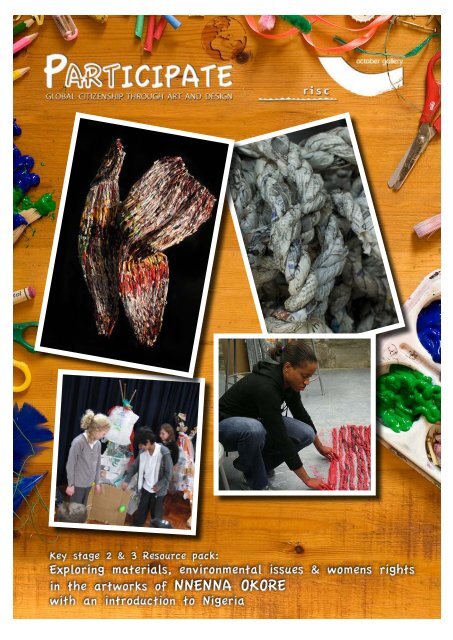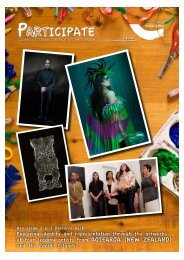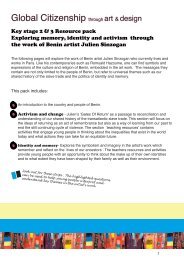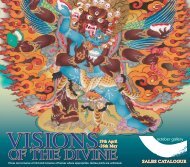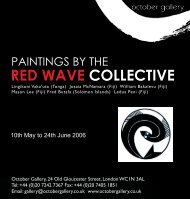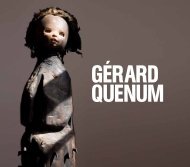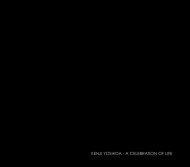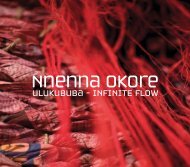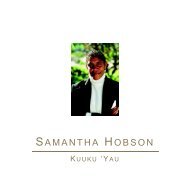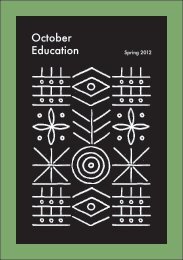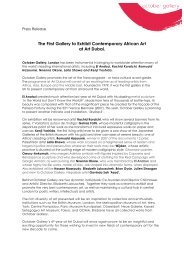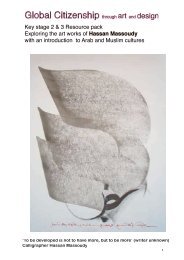Create successful ePaper yourself
Turn your PDF publications into a flip-book with our unique Google optimized e-Paper software.
Key stage 2 & 3 Resource pack:<br />
Exploring materials, environmental issues & womens rights<br />
in the artworks of NNENNA OKORE<br />
with an introduction to Nigeria
Contents page<br />
3 An introduction to Nigeria<br />
5 <strong>Nnenna</strong> <strong>Okore</strong> and her work<br />
7 Paper projects: A brief history of paper<br />
Why do trees matter? Useful information on deforestation<br />
Activities:<br />
1- Make your own paper<br />
2- Paper shelters<br />
3- Paper body sculptures<br />
16 <strong>Nnenna</strong> <strong>Okore</strong> and Women’s Rights: Activities and recommended resources<br />
exploring equality and gender issues<br />
Activities:<br />
1- William’s doll<br />
2- Which is the odd one out<br />
3- Make your own toy store catalogue<br />
19 <strong>October</strong> <strong>Gallery</strong> interview with <strong>Nnenna</strong> <strong>Okore</strong><br />
24 Images of <strong>Nnenna</strong> <strong>Okore</strong>’s work<br />
32 Your comments<br />
What is Global citizenship?<br />
“.....Global Citizenship is more than the sum of its parts.<br />
It goes beyond simply knowing that we are citizens of the<br />
globe to an acknowledgement of our responsibilities both to<br />
each other and to the Earth itself. Global Citizenship is about<br />
understanding the need to tackle injustice and inequality,<br />
and having the desire and ability to work actively to do so.<br />
It is about valuing the Earth as precious and unique, and<br />
safeguarding the future for those coming after us. Global<br />
Citizenship is a way of thinking and behaving. It is an outlook<br />
on life, a belief that we can make a difference”<br />
Oxfam’s definition of global citizenship<br />
http://www.oxfam.org.uk/education/gc/<br />
2
The Federal Republic of Nigeria<br />
Geography<br />
Nigeria is a West African country bordering Cameroon to the east,<br />
Benin to the west, and Niger to the north and the Gulf of Guinea to<br />
the south. The largest city is Lagos, which was Nigeria’s capital city<br />
until 1991, when the nations capital was officially moved to Abuja for<br />
its more central location.<br />
The total surface area is 356,668 square miles. Arable land consists<br />
of 33% of the surface area and the climate is tropical in the south<br />
and arid to the north. Natural resources include oil (one of the world’s<br />
largest producers and exporters, on a similar scale to Kuwait), natural<br />
gas, tin, iron ore, coal, limestone, niobium, lead and zinc. Their main<br />
agricultural products are cocoa, peanuts, palm oil, corn, rice, sorghum,<br />
millet, cassava, yams, rubber, timber and livestock.<br />
BBC news: a timeline with a brief history of Nigeria<br />
http://news.bbc.co.uk/1/hi/world/africa/1067695.stm<br />
People<br />
Nigeria, Africa’s most populous country (148 million -UN, 2007) is composed of<br />
more than 250 ethnic groups; the following are the most populous and<br />
politically influential: Hausa and Fulani 29%, Yoruba 21%, Igbo (Ibo) 18%, Ijaw<br />
10%, Kanuri 4%, Ibibio 3.5%, Tiv 2.5%.<br />
There are 300 languages with the three main official languages being Hausa,<br />
Yoruba, Igbo (Ibo), Fula.<br />
The major religions are: Islam (50%), Christianity (40%) and indigenous<br />
beliefs* (10%). There is also a small Jewish, Baha’i and Hindu following.<br />
* indigenous beliefs are extremely diverse, also some of the earliest Christians and Muslims were<br />
Africans, therefore the term ‘Indigenous religions’ can be problematic, especially if referring to<br />
faiths predating the Colonial period. In this case we have used the term ‘indigenous religions’ to<br />
describe faiths that are mainly practised locally and less well known than global religions such as<br />
Christianity and Islam. These faiths are mainly based on the practices of their ancestors, combined<br />
with new innovations and spread to countries like South America and Haitti as a result of the<br />
Transatlantic Slave Trade.<br />
Nigeria’s Women’s football team at the<br />
Women’s Football World Cup 2008<br />
Ancestral shrine<br />
Ecumenical Church, Abuja<br />
Nigerian National Mosque, Abuja<br />
Environmental issues (CIA world fact book)<br />
•Soil degradation •Rapid deforestation •Urban air and water pollution •Desertification •Oil pollution- water air, and soil<br />
has suffered serious damage from oil spills •Loss of arable land •Rapid urbanization<br />
Environmental agreements<br />
party to: Biodiversity, Climate Change, Climate Change-Kyoto Protocol, Desertification, Endangered<br />
Species, Hazardous Wastes, Law of the Sea, Marine Dumping, Marine Life Conservation,<br />
Ozone Layer Protection, Ship Pollution, Wetlands, Signed but not ratified: none of the selected agreements<br />
3
Shell in Nigeria (Friends of the earth)<br />
www.foe.co.uk/campaigns/economy/case_studies/shell_index.htm<br />
•Nigeria is one of the largest producers of oil in Africa yet half its population<br />
lives in poverty.<br />
•Shell is the second largest oil and Gas Company in the world. It operates in<br />
more than 145 countries.<br />
•Their operations demonstrate how badly companies can affect the communities<br />
they operate in. Shell has been working in the Niger Delta since 1956, causing<br />
problems to:<br />
Local communities - gas flares burn day and night, roaring like jet engines and<br />
polluting the air with thick sooty particles that stick to almost everything and have<br />
serious health impacts.<br />
Livelihoods - oil is a root of conflict and suffering in Nigeria. Over 1000 lawsuits<br />
have been filed against Shell, yet it still refuses to pay compensation costs.<br />
The environment - polluting oil spills and fires have occurred for decades due to<br />
Shell’s rusting pipes seriously affecting local villages, bio-diversity, and contributing<br />
towards climate change.<br />
Gas flaring in the Niger Delta<br />
The Nigerian government banned gas flaring in 1969, but Shell continues to flout the<br />
law and there have been over 4,000 oil spills in the Niger Delta since 1960<br />
Campaigns and articles:<br />
•Women taking the lead in reversing climate change: www.wrm.org.uy/bulletin/111/Women.html<br />
•Nigerians file oil lawsuit against Shell in the Netherlands: www.foe.org.au/corporates/media/news-items/front-pagenews-feed-1/nigerians-file-oil-lawsuit-against-shell-in-<br />
the-netherlands<br />
•www.remembersarowiwa.com<br />
“The writer cannot be a mere storyteller; he cannot be a mere teacher; he cannot merely X-ray society’s<br />
weaknesses, its ills, its perils. He or she must be actively involved shaping its present and its future.”<br />
Ken Saro-Wiwa (1941-1995) Writer, Journalist businessman and activist<br />
On November 10th 1995, Ken Saro-Wiwa and eight Ogoni colleagues were executed by the Nigerian state for campaigning<br />
against the devastation of the Niger Delta by oil companies, especially Shell and Chevron<br />
In 1990, Saro-Wiwa started to dedicate himself to the amelioration of the problems of the oil producing regions of the<br />
Niger Delta. Focusing on his homeland, Ogoni, he launched a non-violent movement for social and ecological justice.<br />
In this role he attacked the oil companies and the Nigerian government accusing them of waging an ecological war<br />
against the Ogoni and precipitating the genocide of the Ogoni people. He was so effective, that by 1993 the oil<br />
companies had to pull out of Ogon.<br />
Deforestation in Nigeria- see page 9<br />
Children’s books: Series on Nigeria by Ifeoma Onyefulu<br />
Ifeoma Onyefulu is a Nigerian photographer currently living in the UK. These beautifully printed books are mainly a<br />
reflection of rural life in Nigeria. However teachers should be aware that these books do not show the diversity of lifestyles<br />
and people of Nigeria and may reinforce stereotypes of life in Africa.<br />
A is for Africa (alphabet)<br />
Emeka’s Gift (counting 1-10)<br />
One Big Family (families)<br />
Ebele’s Favourite (games)<br />
An African Christmas<br />
My Grandfather is a Magician (jobs)<br />
Welcome Dede (naming ceremony)<br />
Here Comes our Bride (wedding ceremony)<br />
Saying Goodbye (funeral ceremony)<br />
Chidi Only Likes Blue (colours)<br />
A Triangle for Adaora (shapes)<br />
4
<strong>Nnenna</strong> <strong>Okore</strong> and her work....<br />
Artists Biography<br />
<strong>Nnenna</strong> was born in Nigeria and currently lives in the USA where she lectures in Art at North Park University, Chicago.<br />
She received her BA degree in Painting from the University of Nigeria (First Class Honors) in 1999, and an MA and<br />
MFA. in Sculpture from the University of Iowa in 2004 and 2005. She has received several awards and residencies<br />
worldwide, and been shown in numerous prestigious galleries and museums within and outside the United States.<br />
Current work<br />
“Currently, I am invested in forms that explore, or are inspired by intimate spaces, shelters, architectural and natural<br />
environments, and ideas related to textures, colors, qualities and social values associated with African fabrics, using<br />
multiples and repetitive processes” <strong>Nnenna</strong> <strong>Okore</strong><br />
<strong>Nnenna</strong> <strong>Okore</strong>’s Inspiration<br />
Much of <strong>Nnenna</strong>’s work is inspired by rural life and her child hood years in Nsukka, a small university town in Southern<br />
Eastern Nigeria. Her work connects to memories of the natural landscape, discarded objects, dilapidated buildings,<br />
nests and shelters.<br />
“As a child, I was fascinated by the social, natural, and artificial* conditions in rural dwellings around the University<br />
campus. Embedded within its landscape were evocative imageries captured within its rocky slopes, and architectural<br />
structures. I came across several stunning traditional art and architectural forms, such as, roofed shrines<br />
characterized by huge mounds of sand under a thatched structure, and yam barns and fences that traced the borders<br />
of people’s compounds” <strong>Nnenna</strong> <strong>Okore</strong><br />
*Artificial: materials produced or formed or made by humans that do not result from natural processes.<br />
Materials in her work<br />
<strong>Nnenna</strong> was inspired by all aspects of rural life, in particular the culture and innovation of reusing discarded objects,<br />
seeing all materials as precious commodities. Living in America has made her reflect on the way societies regard and<br />
value their materials and resources and also the impact of consumerism on our natural environment.<br />
When she moved to America she was surprised at the abundance of materials, how much people consume and how<br />
much of it is just thrown away. Even though there is a huge recycling industry in America, she felt that it was seen in a<br />
different light to how is it used and understood by people in Nigerian society.<br />
“In Nigeria people may use them in other ways such as using paper to wrap foods or a table cloth, old can as lamp<br />
shades - children would make toys out of plastics, you are very aware of the recycling culture out there.......<br />
“ .....Reclaiming recycled materials became a huge part of my work- Reclaiming, reforming, reconditioning,<br />
reconstructing what was no longer considered useful. I was trying to find meaning to them, to find ways to give them<br />
value” <strong>Nnenna</strong> <strong>Okore</strong><br />
She uses a variety of discarded and found materials, in particular paper, such as newspapers, magazines and old<br />
phone books. In her work she transform them into shields, baggages made from plastic bags or a rope made from<br />
paper.<br />
As well as discarded or found materials she uses clay:<br />
“I came into contact with clay for the first time in my<br />
little community in Nsukka, where the landscape<br />
has a lot of clay deposits and so I would often play<br />
with the sand – it was a material that the locals were<br />
very connected to. I appreciate clay because of the<br />
connection I had with it growing up in Nsukka”<br />
<strong>Nnenna</strong> <strong>Okore</strong><br />
sheild me, paper 2008<br />
rope 2006<br />
5
<strong>Nnenna</strong> <strong>Okore</strong> and textiles<br />
If you look at <strong>Nnenna</strong>’s work you may be reminded of a piece of fabric, but instead of being made out of cloth she<br />
uses paper or clay. Her use of materials to create pieces with the qualities of fabric and texture, colour and shape<br />
connects to how we understand the importance of fabric in society. For example the richer the quality of fabric and its<br />
colors often will signify that it’s wearer is affluent, their status in society; or particular type of fabric or garment will be<br />
worn as part of a celebration or a festival. <strong>Nnenna</strong> tries to reflect the mood of the occasion and how the wearer feels in<br />
the fabric and her work refers to the way fabric is worn within Nigerian society.<br />
Igba Nkuwu (front cover image)<br />
“When a woman is about to marry, the original pre-Christian wedding is performed, and<br />
the women see this as a festive period, a chance to really dress up, to be glamorous, to<br />
wear the most expensive kind of fabric. It would be a time to celebrate their femininity, to<br />
really be graceful and grateful in their movement and in their carriage. I called the piece<br />
Igba Nkuwu because for me it really embodies the characteristics of that kind of festivity<br />
and mood” - <strong>Nnenna</strong> <strong>Okore</strong><br />
<strong>Nnenna</strong> was also a student of the Internationally recognised Ghanaian artist, El Anatsui.<br />
He produces a diversity of work but is most well known for his large-scale installations<br />
in the traditions of the kente cloth from reclaimed materials in particular whisky bottle<br />
tops. You can find his work In the Africa gallery of the British museum and most recently<br />
adorning the Channel 4 building in London.<br />
http://www.octobergallery.co.uk/artists/anatsui/index.shtml<br />
Processes<br />
Nnena uses many manual processes in her work such as twisting and weaving. She usually starts with making<br />
smaller parts or units, which she repeats and then brings together to create a larger work, a sculpture or installation.<br />
“A lot of my processes are very rigorous and labour intensive, and simplistic in nature – I’m twisting papers, I’m rolling<br />
them up, crumpling them up, smashing them, dying them. Because they occur in numbers, they tend to be a lot of<br />
work to do. I’m waxing them, sewing, tying, roping – what draws me to<br />
these processes are the patterns and shapes and textures that result<br />
when they’re assembled – these are things that attract me the most<br />
– colour is something that I really appreciate when I’m putting these<br />
processes together and forming the piece I’m making. I’m interested<br />
in the way the pieces come together – a lot of them are very accidental<br />
– I put them together and I’m amazed at how the variation in each<br />
particular unit can create very interesting modulations, textures, colours,<br />
undulations, and repetitive patterns in the piece” - <strong>Nnenna</strong> <strong>Okore</strong><br />
These extracts were taken from an interview with <strong>Nnenna</strong> <strong>Okore</strong> by<br />
Polly savage in 2008. Please refer to the back pages if you would like to<br />
read the full interview.<br />
For further information on <strong>Nnenna</strong> <strong>Okore</strong>’s work please see<br />
www.octobergallery.co.uk/artists/okore<br />
www.nnennaokore.com<br />
6
Paper Projects<br />
paper a brief history<br />
BC<br />
3500 BC<br />
The earliest known use of paper was in Egypt. It was made from beaten strips from the papyrus<br />
plant and sold to ancient Rome and Greece.<br />
Outside Egypt, parchment or vellum, made of processed sheepskin or calf skin<br />
replaced papyrus.<br />
AD<br />
2nd c<br />
Paper produced in China. Ordinarily, documents were written with heavy bone or bamboo (as<br />
tablets or bamboo cut into strips) which were extremely heavy to transport, or occasionally on<br />
lighter, but more expensive silk.<br />
Normally paper was used for wrapping and other purposes.<br />
105<br />
3rd c.<br />
Invention of modern methods of papermaking (inspired by wasps and bees) from rags and other<br />
plants). However, it is suggested that paper was in use by the ancient Chinese military more<br />
than 100 years earlier, in 8BC.<br />
Paper used for writing became widespread.<br />
5th c.<br />
The Mayans invented a parchment called amate, which is made by boiling and pounding the<br />
inner bark of trees. It was widely used until the Spanish conquest, and is still made today for<br />
greeting cards and paintings.<br />
The technology of papermaking slowly spread beyond China, was transferred to Korea and then<br />
imported to Japan.<br />
6th C<br />
Toilet paper first used in China.<br />
Paper was folded and sewn into square bags to preserve the flavour of tea in China.<br />
686<br />
The world’s earliest known printed book, the “Diamond Sutra” in China.<br />
8th c.<br />
From China, the use of paper began to spread out through the Islamic world.<br />
10th c.<br />
The world’s first known paper money was produced in China.<br />
11th c.<br />
Oldest known paper document in the West, the “Mozarab Missal of Silos”, probably written in the<br />
Islamic part of Spain.<br />
7
12th c.<br />
Use of paper began in Europe.<br />
1120<br />
Europe’s first paper mill in Islamic Spain<br />
13th c.<br />
More mills appeared in Italy, as an import from Islamic Spain. They used hemp and linen rags as<br />
a source of fibre.<br />
1400<br />
Paper is widely manufactured in Italy and Germany.<br />
Woodcut printmaking technique was transferred from fabric to paper.<br />
15th c.<br />
Johannes Gutenberg revolutionised Printing Press.<br />
1588<br />
First commercially successful paper mill in England was opened by John Spilman near Dartford in<br />
Kent and was initially reliant on German papermaking expertise.<br />
early 19th c.<br />
Invention of the stem-driven paper making machines, which could make paper with fibres<br />
from wood pulp. The Fourdrinier paper making machine became the basis for most modern<br />
papermaking.<br />
Paper became commonly used for writing and printing and was daily used in other areas.<br />
8
Why do trees matter?<br />
<strong>Nnenna</strong> uses reclaimed paper in her work, commenting on the environmental damage that is caused by our increasing<br />
culture of consumption. In Nigeria has the worlds highest rate of deforestation. Between 2000 - 2005 the country lost<br />
55.7 % of its primary forests (according to revised deforestation figures from the Food and Agriculture Organization of<br />
the United Nations ) news.mongabay.com/2005/1117-forests.html which has been cleared for subsitance farming,<br />
logging and for fuel. Primary forests are ‘old growth forests’ that have been untouched by human activity. They are<br />
extremely important and have the highest number of plant and animal species.<br />
if trees could talk..<br />
We provide homes for a diverse and rich community..<br />
Tropical Rainforests presently give a place to call home for<br />
50% - 90% of all organisms, 90% of primates, and 50 million<br />
creatures that can live no place but the rich rainforests. By<br />
chopping us down these species and organisms are under a<br />
threat of extinction.<br />
Human life wouldnt be the same without us..<br />
Humans also benefit and depend on rain forests. We provide a<br />
wealth of renewable resources: nuts, fruit and game, timber<br />
and medicinal plants. In fact the forests provide 25% of life<br />
saving medicines and then there are all the medicines that are<br />
yet to be discovered or that have been destroyed.<br />
There is also the danger of wiping out communities who directly<br />
depend on our natural resources for their everyday survival<br />
Mother nature gave us an important role<br />
Us trees regulate the weather and also are a crucial natural defense<br />
against climate change, by trapping particles of carbon and other<br />
particles that are produced by pollution. We also determine rainfall by<br />
replenishing the skies with water. The water also forms clouds, which is<br />
another way of protecting the earth from the sun’s heat.<br />
Useful websites on deforestation<br />
www.umich.edu/~gs265/society/deforestation.htm<br />
The mystery of Easter Island is a prime example of what deforestation can do to a society -<br />
www.mongabay.com/09easter_island.htm<br />
Campaigns<br />
Greenpeace campaign against deforestation: www.greenpeace.org/international/campaigns/forests<br />
Environmental Investigation Agency - Forests for the world campaign www.eia-international.org/campaigns/forests<br />
Recommended reading<br />
Aani and the tree huggers by Jeannine Atkins ISBN: 1_58430_004_3 LEE & LOWE books,inc.<br />
A story based on the real events in Northern India, the women were known as Chipko<br />
andolan (‘hug the tree movement’) and were victorious in preventing loggers from destroying their precious forests.<br />
9
Activity 1: Make your own paper<br />
+ Select the pieces of paper to be recycled. You can even mix different types to create your own unique paper.<br />
+ Rip the paper into small bits, and place into the blender (about half full). Fill the blender with warm water. Run the<br />
blender slowly at first then increase the speed until the pulp looks smooth and well blended. ( 30 -40 seconds) Check<br />
that no flakes of paper remain. If there are, blend longer.<br />
+ The next step is to make a mould. The mould, in this case, is made simply by stretching a mesh (such as net<br />
curtains, or aluminium mesh from a car repair shop) over a wooden frame and stapling it. It should be as tight as<br />
possible, or you can buy a deckle and mould from a craft shop.<br />
+ Fill the basin about half way with water. Add 3 blender loads of pulp (the more pulp you add the thicker the<br />
finished paper will be). Stir the mixture.<br />
+Place the mould into the pulp and then level it out while it is submerged. Gently wiggle it side-to-side until<br />
the pulp on top of the screen looks even.<br />
+Slowly lift the mould up until it is above the level of the water. Wait until most of the water has drained from the<br />
new paper sheet. If the paper is very thick, remove some pulp from the tub. If it is too thin, add more pulp and<br />
stir the mixture again.<br />
+ When the mould stops dripping, gently place one edge on the side of a fabric square (felt or flannel square). Gently<br />
ease the mould down flat, with the paper directly on the fabric. Use a sponge to press out as much water as possible.<br />
Wring the excess water from the sponge back into the large plastic tub.<br />
+ Now comes the tricky part. Hold the fabric square flat and slowly lift the edge of the mould. The wet sheet of paper<br />
should remain on the fabric. If it sticks to the mould, you may have pulled too fast or not pressed out enough water.<br />
It takes a little practice. You can gently press out any bubbles and loose edges at this point.<br />
+ Repeat the steps above, and stack the fabric squares on a baking sheet. Save one fabric square to place on the top<br />
of the stack to cover the last piece of paper. Use another baking sheet to press the remaining water out of the stack<br />
(do this outside or in the bathtub, it can make a mess).<br />
+ After you press the stack, gently separate the sheets. They can be dried by hanging on a clothesline or laying them<br />
out on sheets of newspaper. When they have dried peel them off the fabric and voila! You have paper!<br />
10
Activity 2:<br />
Twisting<br />
Binding rolling<br />
connecting curling<br />
Discuss<br />
Looking at examples of <strong>Nnenna</strong>’s work, ask your students to think about:<br />
•The materials her structures are made from<br />
•Where do the the materials came from?<br />
•How the artist has manipulated and transformed the<br />
materials (twisted, rolled, cut, waxed)?<br />
•How has the artist joined the material ?<br />
•What the pieces represent? (what do they look like?)<br />
refering to Pages 3 & 6 discuss:<br />
•Nnena’s inspiration<br />
•Materials in her work<br />
•textiles<br />
•procesess<br />
•<strong>Nnenna</strong>’s background<br />
constructing<br />
In this activity students: create architectural forms in response to their<br />
natural and human made environment<br />
Think about the way in which our built environment reflects people,<br />
place and time.<br />
Students will then design and construct pieces by manipulating and<br />
transforming found materials, investigating repetitive techniques<br />
Record<br />
Using digital cameras or mobile phones ask students to photograph srtuctural forms in their neighbourhood.<br />
These may be natural or artificial.<br />
•The interiors and exteriors of their homes or other buildings that interest them<br />
•Natural forms such as trees, rocks, hills<br />
•Shelters- bus stops and bird boxes<br />
Are there any memories connected to these structures? Why did they choose to photograph it? What materials<br />
were used to build it and why?<br />
Architectural forms are the buildings and structures that surround us. The designs or styles of<br />
these constructions refflect a particular culture,place or a period of time.<br />
11
Design<br />
In class print and assemble a montage of all the student’s images, stick them to a local map of the<br />
area, and attach memories or comments to their pictures.<br />
Ask pupils to think about designing their own structures based on the their photographs. Ask them to<br />
consider the most important features of these structures- protection, comfort, aesthetics<br />
(their shape and form).<br />
Build<br />
Pupils will create their own structures in the classroom. This may be collaborative.<br />
Using paper materials such as old phone directories, shredded paper, cardboard boxes, scraps<br />
of paper, hole punch, washing line, wire, plastics, thread, needles. How are they going to join the<br />
materials? How will they make the material stronger (roll it, scrunch it)? Encourage students to<br />
experiment and play with the paper.<br />
WARNING!<br />
MESSY ACTIVITY!<br />
Pupils from Alfred Sutton Primary School<br />
made their own <strong>Nnenna</strong> <strong>Okore</strong> inspired<br />
shelters from recaimed materials and<br />
bamboo. Among the finished products were a<br />
home for bats and a mouse hut!<br />
12
Inspired by <strong>Nnenna</strong> <strong>Okore</strong><br />
A’ level pupil Ifrah took part in one of our workshops. In<br />
response to <strong>Nnenna</strong>’s work she created a large sculpture<br />
made from a very long single length of platted materials<br />
including dyed newspaper, various fabrics dyed different<br />
colours, silver foil, cling film and netting. Her spectacular<br />
sculpture formed an integral part of her A’ level portfolio,<br />
helping her to achieve a place at the art college of her<br />
choice. She plans to explore these techniques further<br />
during her time there.<br />
13
Activity 3: <strong>Nnenna</strong> <strong>Okore</strong> and textiles<br />
Paper body sculptures<br />
Ask students to think about the types of clothing they wear to special occasions, uniforms for a<br />
school or club (sports, scouts), or their favourite fashion item this season. Ask them to describe<br />
how they feel when they are wearing them, does it make you stand out in a crowd or blend in with a<br />
group? Is there a particular way that they wear it that is unique to them (the way they wrap a scarf<br />
or tie a belt)?<br />
Looking at <strong>Nnenna</strong> <strong>Okore</strong>’s work ask pupils to imagine them being worn as clothing.<br />
considering the colours, textures and the form: how and where would they be worn<br />
(also see activity 1).<br />
Pupils can work in groups or individually to design and make paper body sculptures: sculptures that<br />
people can wear, that shelter the body, but also say something about the person wearing it.<br />
- where will it be worn?<br />
- how will it be worn?<br />
- how do you think the person feel wearing it?<br />
Encourage pupils to be free with their designs (they do not have to make something that looks like<br />
a familiar) They can take inspiration from natural forms, natural and synthetic architecture (collect<br />
pictures from magazines, take photographs, see activity 1).<br />
Show pupils how the can create different textures and patterns by manipulating the paper. They can<br />
also use paints to dye the paper.<br />
Examples of students work from Gospal Oak Primary School, London<br />
14
<strong>Nnenna</strong> <strong>Okore</strong> and Women’s Rights<br />
<strong>Nnenna</strong> <strong>Okore</strong> has travelled widely, including many<br />
countries in Africa and Europe as well as Australia,<br />
China. Her travels took her to the fifth Regional<br />
Conference on Women in Dakar (1994) Senegal<br />
and the Fourth World Conference on Women in<br />
Beijing, China (1995). She organized Youth Service<br />
Workshops in Nsukka, and other youth art workshops<br />
in Swaziland. Her interests include membership in the<br />
Women in Law and Development in Africa (WILDAF).<br />
United Nations Development Fund for Women:<br />
www.unifem.org<br />
Why does gender matter?<br />
News Flash!<br />
Women in Parliament World Ranking<br />
1st Rwanda 49%<br />
2nd Sweden 45.3%<br />
3rd South Africa 45% (at their latest election)<br />
4th Cuba 43%<br />
58th UK 19%<br />
www.ipu.org/wmn-e/classif.htm<br />
Information correct on 30th April 2009<br />
Did you know?<br />
On average male artists’ work<br />
sells for 10 times more than<br />
equivalent female artists’<br />
work.<br />
(Sotheby’s –<br />
The Independent)<br />
How many male artists can you name?<br />
How many female artists can you name?<br />
Which scientist discovered radio active metals?<br />
Marie Curie<br />
What did Kenyan Environment Minister Wangari Maathai win the Nobel Peace Prize for?<br />
Planting 10 million trees and rejuvenating Kenya’s soil and water conditions<br />
When did women in Britain win the right to vote?<br />
1928<br />
In what year was the first picture of a female sportsperson on the cover of Sports Illustrated<br />
Magazine?<br />
1987<br />
Did you know? Women working full time in the UK are paid on average 17% less than men.<br />
(36% less if working part time)<br />
16
Activity 1 William’s Doll – Charlotte Zolotow<br />
+ Read “William’s Doll’ over 20 minutes at the end of the day.<br />
+ Look at the front page and the title and predict what the story will be about.<br />
+ It is William on the front page? If so, then why is he throwing a basketball?<br />
+ Discuss what William’s brother means when he uses the term ‘sissy’ and ‘creep’.<br />
+ Is he being respectful of William and his feelings? How would those words make William feel?<br />
+ Why didn’t William’s dad want him to have a doll? Who understood William the most?<br />
+ Why did Grandma think it was important for William to have a doll?<br />
+ What values did William have?<br />
+ Encourage the discussion around issues of gender and gender roles. Focus on the positive<br />
values that William demonstrates<br />
Activity 2 Which is the Odd One Out?<br />
Aim: to initiate discussion around gender roles in jobs and society<br />
You Will Need: Focus for Change pack, or similar images.<br />
+ In the teaching pack ‘Focus For Change’, you will find a series of images that can be used to<br />
challenge gender roles and stereotypes.<br />
+ Select images 3, 4, 5, 6, 9, 10, 11, and 23 from the pack (or you can find your own images that<br />
raise gender issues and that could be used to challenge gender stereotypes).<br />
+ Ask pupils to choose one picture from the above list that interests them, or about which they<br />
have a question they’d like to ask.<br />
+ Form groups of 3 with pupils who have chosen different pictures to one another.<br />
+ In these groups, decide which of the 3 different images is the odd one out and why.<br />
17
+ Read the information about the picture in the back of the Focus for Change pack;<br />
+ In your groups, discuss the questions it raises about assumptions surrounding gender<br />
roles in our society. Note down your discussion.<br />
+ Feed back your thoughts to the rest of the class<br />
All Change Jobs!<br />
+ Use the all change jobs book as a stimulus for thinking about gender job roles.<br />
+ Design your own book using reclaimed materials, with a cut out boy and girl to fit into<br />
each pocket.<br />
+ Think of a range of jobs, sports, cultural activities etc. to include in your book.<br />
Activity 3 Make your own toy catalogue<br />
Aim: to challenge gender stereotypes and perceptions of gender roles<br />
You will need: toy shop catalogues, scrap paper, pens and scissors, glue<br />
+ Explain to pupils that they are going to design a toy catalogue for younger children<br />
+ Discuss with pupils how it feels to be excluded from an activity or game because of their gender.<br />
Have they ever experienced this? How did it make them feel?<br />
+ In groups, take a look at the catalogues. Are toys targeted at boys and girls? How can you tell?<br />
+ How do you feel about these pictures? Do they think these images represent what all girls and<br />
boys like doing? Should children be allowed to play with any toys regardless of gender? Think<br />
about other ways advertising might influence your choices.<br />
+ Ask pupils to design their own page of a toy catalogue that doesn’t stereotype children by either<br />
cutting up pictures from newspapers and magazines, drawing, or using digital cameras to take<br />
photos.<br />
Useful Resources<br />
Make Some Noise Facts and Figures at www.fawcettsociety.org.uk<br />
Focus for Change<br />
This photo pack and teaching resource is full of ideas and activities to challenge stereotypes to<br />
stimulate discussion. The resource is out of print, but free copies are available from RISC (with a<br />
£5 contribution to p&p). Please contact liz@risc.org.uk to order your copy.<br />
Change the World in 8 Steps<br />
This set of posters from Oxfam introduces the 8 United Nations Millennium Development goals to<br />
pupils aged 7 to 14. Each A2 poster has a colour photograph on one side and several activities on<br />
the back.<br />
Boots for a Bridesmaid – Verna Allette Wilkins<br />
This is a simple and accessible story of a young girl who doesn’t want to wear a frilly bridesmaid’s<br />
dress at a wedding. She is encouraged to find a compromise, and keeps her large boots on<br />
underneath. This story is also useful for representing diverse families.<br />
William’s Doll – Charlotte Zolotow<br />
A simple and powerful story about a boy who wants a doll to play with. His father thinks it’s not an<br />
appropriate toy for a boy, so buys him a train set and a basketball. William loves them both, and is<br />
very good at basketball, but he still wants a doll. Eventually, his grandmother buys him one, and<br />
explains to his father that playing with a doll will help him to be a better father when he grows up.<br />
A great tool for raising gender issues and empowering young boys to be themselves.<br />
18
Amazing Grace – Mary Hoffman<br />
This is a lovely, positive and beautifully illustrated story about Grace, who loves to act. When<br />
her school decides to perform Peter Pan , Grace decides she’d be perfect for the leading role as<br />
Peter. Her classmates say that Peter was a boy, and besides, he wasn’t black... But Grace’s mum<br />
and grandma tell her she can be anything she wants if she puts her mind to it.<br />
80:20 Development in an Unequal World<br />
This book, useful for background research, introduces several topical development and human<br />
rights issues in an accessible format, culminating in suggestions for taking action.<br />
19
<strong>Nnenna</strong> <strong>Okore</strong><br />
Interviewed by Polly Savage 18/09/08 Iowa/ London<br />
PS: Are you working with a particular tradition of textiles in Nigeria?<br />
NO: I’m working with the social understanding of fabric in Nigerian society, and how Nigerians<br />
attach a lot of sentiment to the kind of fabric they have, or the kind of clothes they wear, because<br />
it defines their self esteem, their carriage. The richer the quality of the fabric, the higher the<br />
self- esteem of the wearer. They have many clichés or names that they attach to a specific kind<br />
of fabric. Some of those I try to capture in the work, for example in my work Igba Nkwu, which<br />
denotes the pre-wedding ceremony of a young woman. When a woman is about to marry, the<br />
original pre-Christian wedding is performed, and the women see this as a festive period, a chance<br />
to really dress up, to be glamorous, to wear the most expensive kind of fabric. It would be a time to<br />
celebrate their femininity, to really be graceful and grateful in their movement and in their carriage.<br />
I called the piece Igba Nkuwu because for me it really embodies the characteristics of that kind<br />
of festivity and mood. Many of my fabrics are not about a particular kind of prototype or cultural<br />
identity, it’s more about defining their mood and the people and their carriage and the way it gives<br />
them a sense of pride and affluence, because a lot of times fabric defines your status in society.<br />
This piece called Oriaku makes reference to a woman who is in an affluent home, who receives<br />
a lot of gifts from her partner, and who is well taken care of, and she is called an oriaku – literally<br />
it means someone who is enjoying the affluence of her home, celebrating their affluence. When<br />
I was growing up in Nigeria in the 80s, it was a time when there was a little bit of stability in our<br />
economy, things were really good in the early 80s and a lot of women at the time were really taken<br />
with this kind of fashion that featured lacy, spirally designs, transparent materials, and they would<br />
wear these, and float around and feel really fabulous and glamorous, so I think for me, the name<br />
Oriaku embodies that period and the people. Other pieces also, like ‘sample material’ and ‘dance<br />
piece’ – I’m alluding to how people generally feel about their fabrics. In the market place there<br />
are lots of wealthy lovely displays of a range of fabrics. Sometimes they have sample materials<br />
– one of a kind fabric that they would display, they would come in strips of cloth, very limited in<br />
edition, in quantity. These are generally very sought after – they are one of a kind, very delicate,<br />
very sought after. I like the idea of embodying the need people have for this kind of fabric – this<br />
sought after fabric. Whenever you go to a fabric store, they will ask you whether you want to see<br />
the samples, they have them displayed in strips all over the store. Also the dance piece – that for<br />
me is trying to embody the lifestyle of people – cloth and festivity for me often work hand in hand,<br />
especially among the wealthy Nigerians. Those in the lower sectors of society may not agree with<br />
this, but among the more wealthy sectors there is this sense of showing off, or exhibition of wealth<br />
when you are wearing cloth. There is also a sense of festivity – people want to dance, want to<br />
be seen in their various kinds of attires. I think that ‘Dance’ speaks to me about how people carry<br />
themselves, and feel free-spirited, like butterflies – it is a lifting of their spirits.<br />
PS: Do you feel critical of these kinds of practices? Do you see your work as social critique? Or<br />
are you celebrating these aspects of Nigerian culture?<br />
NO: I am definitely more critical than celebratory. Whilst I know it is a norm for people to want to<br />
celebrate their Nigerian dress culture through dress and fabric, I think it is only a small minority<br />
who get to enjoy these kinds of practices and fabrics. I think this creates a sense of misplaced<br />
priorities, because when these status quos are created there are so many who can’t afford<br />
these things, and this kind of culture forces people who can’t afford it to go borrowing, in order to<br />
maintain that kind of status quo. So I’m not celebrating it, I’m only commenting on what I see, and<br />
20
what I live with. I come from a humble home – I’m not known to try to display a lot of affluence or<br />
wealth, so I see it from that perspective.<br />
Some other pieces from this series are exploring texture, process, the innovation of using found<br />
materials. That is the one big thing that I have seen happening that really inspired me in many<br />
ways, amongst the less privileged Nigerians, who couldn’t afford to lead these more affluent and<br />
comfortable lives – they would be very quick to find ways to accommodate their situation – so I<br />
have some pieces in there that speak more about transformation and reformation – for instance,<br />
Baggage, which is made out of plastic bags – another piece – Rope – and Shield Me, also Fence<br />
– these pieces have more commentary on recycling, reusing, on trying to find ways that these<br />
materials could be translated. Nigerians may not use them in this manner, but they would use<br />
them in other ways – for instance paper is used as a food wrapper - food peddlars wrap food in<br />
newspaper, or use it as a table cloth – recycled cans are used as lamps – children would make<br />
toys out of plastics – you are very aware of the recycling culture out there. So taking these<br />
materials out here, and trying to make something functional out of them is very meaningful to me.<br />
I’m trying to find a function – I see so many times materials finding a new function, a new meaning,<br />
a new perspective, which can be seen from a very productive point of view.<br />
PS: Is the content of your materials important to your work? The text in your newspapers for<br />
example?<br />
NO: No I don’t particularly pay attention to the text in the newspaper – I try to deconstruct that<br />
– I don’t want it to be what I’m talking about. But I do use a lot of yellow pages, because I feel<br />
they embody our information system, they embody our society – they talk about everyone, about<br />
who we are. So I have more connection to the content of the yellow pages than the content of my<br />
newspapers. With that, I am more interested in considering what they can become – how they<br />
could become other things.<br />
PS: Your use of clay – do you see this as a connection across classes in society, a link between<br />
the materiality of consumption and a more natural connection to the earth?<br />
NO: I came into contact with clay for the first time in my little community in Nsukka, where the<br />
landscape has a lot of clay deposits and so I would often play with the sand – it was a material<br />
that the locals were very connected to. I appreciate clay because of the connection I had with it<br />
growing up in Nsukka, but I don’t necessarily connect clay with the poor.<br />
PS: You use many manual processes in your work – twisting, weaving – could you talk about the<br />
role of process in your work?<br />
NO: I have a strong affinity and obsession with multiples and accumulative processes, so I<br />
repetitively found I tend to make work which is very labour oriented – so I make smaller units,<br />
smaller pieces which I will probably bring together into a larger form or installation. A lot of<br />
my processes are very rigourous and labour intensive, and simplistic in nature – I’m twisting<br />
papers, I’m rolling them up, crumpling them up, smashing them, dying them. Because they<br />
occur in numbers, they tend to be a lot of work to do. I’m waxing them, sewing, tying, roping<br />
– what draws me to these processes are the patterns and shapes and textures that result when<br />
they’re assembled – these are things that attract me the most – colour is something that I really<br />
appreciate when I’m putting these processes together and forming the piece I’m making.<br />
I’m interested in the way the pieces come together – a lot of them are very accidental – I put them<br />
together and I’m amazed at how the variation in each particular unit can create very interesting<br />
modulations, textures, colours, undulations, and repetitive patterns in the piece.<br />
21
PS: You’ve moved around a lot in your life – in what ways have your changing environments<br />
affected your work? How do you feel your work connects with place?<br />
NO: I feel the natural environment here connects more for me than the social or cultural<br />
environment. But I’ve found a lot of similarities and references to my own sensibilities from a<br />
Nigerian perspective – with the landscapes here, which are very familiar to me. I connect with<br />
things like random piles of objects – this brought back memories of Nigeria – things like dilapidated<br />
buildings, nests, the way trees fall – things like this have had an impact on me, resonating with<br />
what I already know. But in terms of picking things up in my work – no, not very much.<br />
PS: What about your work with discarded materials – has living in the United States affected your<br />
perspectives on consumption?<br />
NO: Absolutely. When I moved out here and found in abundance these wasteful cultures and<br />
wasteful outlets of materials – that got me thinking and even pulled me in the direction of how<br />
these materials are so valuable where I come from – of how they mean so much, and are not<br />
wasted as you find them here. Although here there is a huge recycling culture, a recycling<br />
industry, it isn’t with the same intensity – it’s not seen in the same light – there is not so<br />
much value for the materials – they wouldn’t be recycled so instantly as they would in poorer<br />
communities in Nigeria. So yeah, I think I sought to question why there was so much wastefulness<br />
in societies out here, and to investigate the patterns of consumerism where people buy food<br />
without even being able to eat it all – there’s so much out there for people to have, and they’re not<br />
even in dire need of these things. Drawing on what I’ve seen out here, it may have an impact on<br />
the way my work has transformed, especially my attitude to recycled materials. Reclamation and<br />
recycling became a huge part of my work – reclaiming, reforming, reconditioning, reconstructing<br />
what was no longer considered useful. I was trying to find meaning for them, to find ways of giving<br />
them value, especially coming from my background.<br />
PS: Can you talk about your development as an artist? How did you begin working with these<br />
materials? What were the key events that shaped your practice?<br />
NO: I’ve always been interested in creating. I started getting a sense of direction, of space and<br />
sculpture especially, when I came into contact with El Anatsui. I was really inspired by his works<br />
and his approaches to art, and I was very privileged to mentor and work with him for a year<br />
between 2000 and 2001. He was my teacher in my undergraduate programme. My exposure to<br />
him really helped me to begin to appreciate work from a spatial perspective. Before then I studied<br />
painting, so I was more into a two-dimensional, compositional approach to art. When I met El and<br />
spoke to him a few times, we would talk about art, and he always had very insightful feedback<br />
on my work, which helped me broaden my scope beyond the canvas, beyond the paper, and ask<br />
how can I bring my environment and my other experiences into the work. That was like my turning<br />
point, where I started to think about making sculptures and installations, and then I looked around<br />
me, and saw there was so much around that could be transformed into art. I started picking up<br />
leaves, sticks – I would put it together and he would do a critique for me of the works I was doing<br />
independently. I started to feel so comfortable with this that I decided to go to graduate school<br />
and get a degree in this, because it was something that I had so much affinity and drive for, and I<br />
went to graduate school and I really loved it – I found so much passion for sculpture in a way that I<br />
never had bothered to explore in the past. Also coming upon the abundance of waste – that was a<br />
helping point for me so I took it and ran with it and I’ve been running with it since then.<br />
22
PS: Do you see yourself as part of any particular movement? Do you draw influence from the<br />
Nsukka group for example, or any other international movements? Aside from El, who would you<br />
describe as your influences?<br />
NO: I haven’t been able to place myself in any kind of category. There are artists in the diaspora<br />
who are struggling with ideas of identity, and I don’t really see myself in that way because I don’t<br />
think I’m struggling with my identity – I feel very comfortable with who I am and I know where<br />
I’m coming from. I don’t necessarily see myself as coming from the Nsukka school, because I<br />
think it’s not very defined right now what the Nsukka school is. It used to be the school of the Uli<br />
people, of the Uli set, like Uche Okeke and Chika Okeke, and those kinds of people. They kind<br />
of moved on, and I don’t know if we have since found an identity for the school. I know that El<br />
has established a new movement now in Nsukka, where young artists are being more exploratory<br />
and experimental, and less regimented by the old techniques and styles. There’s been a huge<br />
transformation and change of direction by the artists who are there now, but I’m not sure if I would<br />
classify myself with that group because I’m not presently there, and I’m not sure how my work fits<br />
in there. I’m part of the generation that El has brought out – but I’m not sure where I can classify<br />
myself.<br />
PS: It’s interesting what you say about the Nsukka school, which emerged perhaps from the<br />
challenges of independence – maybe those ideas aren’t so urgent for artists now. What challenges<br />
and issues would you say were important to you and your contemporaries at the time you were<br />
working in Nsukka?<br />
NO: One thing I found that was a challenge for me when I was there, and I found very different<br />
when I came here, was the level of exposure that young emerging artists in the Nsukka school<br />
have. I think it’s very useful to see what’s going on the international scene – to visit lots of<br />
museums and exhibitions, to see and talk to lots of artists, and get access to literature and visual<br />
images which relate to these ongoing discourses – I don’t know if we have enough of that – I<br />
mean there is some kind of enlightenment and effort about the need to increase the availability<br />
of resources for artists, but I don’t know if they have enough of them – how much internet access<br />
they have for example, to find out what’s going on with the arts out here, and how other Africans<br />
are exploring new ways, and new techniques – so coming out here really gave me an edge,<br />
because it gave me a broader perspective of art in general – of contemporary art. It was also<br />
inspiring to see work by so many people I had never heard about, both Europeans and Africans<br />
and Americans – and that enriches your vocabulary and your language and understanding of what<br />
you are doing, so I think that in a sense I find myself to be more advantaged than those young,<br />
upcoming artists in Nsukka, because I have more exposure to the art world here. I don’t know how<br />
much things have improved since I left – how much internet access has improved, for example.<br />
PS: What about patronage – is there a lot of support for artists locally in Nsukka?<br />
NO: Yes – that’s the other thing – I know that a few centres and art galleries have opened in<br />
Lagos for artists who are exploring art in unconventional ways. I know some effort has been<br />
put in place to market these artists – I know there is some effort on El’s part to bring Nigerian<br />
artists information about opportunities out here and to engage in discussions out here. Things<br />
are improving, but it’s not enough – we don’t even have enough teachers, we don’t have the<br />
support system, we don’t have the funding. There’s no endowment or group that supports artists<br />
in the way that you get support here. It’s quite a challenging struggle for many of them. But then<br />
again, just because of the peculiar social and economic network – people need to be comfortable<br />
and stable to appreciate art that is experimental – you know you have to be in a state of mind to<br />
indulge in it. In the economic situation now in Nigeria – with people not having enough to eat, and<br />
23
not finding shelter, there are very few people who are interested in experimental art.<br />
PS: What plans do you have for the future? In what directions do you see your work developing?<br />
NO: I’m very interested in getting grants to create architecture – I’m very interested in architectural<br />
forms, but financially I can’t afford the ideas and concepts that I’ve come up with. But I’m working<br />
hard to come up with larger pieces which are referencing architectural spaces from my rural<br />
community – that’s something I’m very interested in – working with architectural forms and spaces<br />
– I think there’s so much to explore to that end. Even in poverty stricken areas there are so many<br />
beautiful forms, with lots of textures and colours. I’m drawn to them and would like to do some<br />
extended work on that, maybe at some point visit the people and talk to them, and find out what<br />
they’re thinking, to see how I can bring some of those emotions to the work as well. So I think in<br />
the near future, I’m going to go a little larger, and maybe even more experimental.<br />
PS: Do you see your work as political? Do you see possibilities or strategies for making it<br />
accessible to these poorer sectors of society, for example?<br />
NO: I do! I’m not sure I can define how I do, but I do see an underlying political tone to the work<br />
that I do – in thinking about class and poverty. I think I can connect with them on a certain level. I<br />
don’t make my work political in a specific way – I am more concerned with form. If my works have<br />
a political undertone then that’s great, but I’m not a politician. I don’t work hard to promote that in<br />
my work, but invisibly it’s always there.<br />
PS: Going back to your title – the butterfly – you talk about your work as being without finite form<br />
– something uncontained – could you talk about this? Does it connect to your ideas about textiles?<br />
NO: Beyond thinking about something that continues to flow, I tend to see my works as animate,<br />
moving forms – very fluid – because of the way I form them. I tend to look at my works as a<br />
having a continuous dance or movement to them – that was the thing that attracted me to a<br />
butterfly, it was very free and fluid – you can follow it and it continues to glide. I try to capture<br />
that in my works, using undulating surfaces, using a lot of suggestive movement – I think that is<br />
how the butterfly comes into my work – it’s very fluid, free-flowing. You could also even see it as<br />
informing the works themselves – each time the work is reinstalled it will reshape into new forms<br />
and pieces. Really that it is it – I see them as free-flowing forms.<br />
Baggage, 2008<br />
plastic bags, 102 x 178 x 26cm<br />
24
Ala Igbe, 2008<br />
Clay and burlap, 231 x 91 x 10cm<br />
25
Ashioke Series, Variation VIII, 2008<br />
Clay and burlap, 71 x 89 x 10cm<br />
26
Ulukububa (infinite flow), 2008<br />
Clay and burlap, 216 x 165 x 20cm<br />
27
Sample Material, 2008<br />
Material and thread, 200 x 64 x 21cm<br />
28
Sample Material (detail), 2008<br />
Material and thread, 200 x 64 x 21cm<br />
29
Shield Me, 2008<br />
Newspaper, acrylic colour, starch, yarn and rope<br />
30
Untitled, 2008<br />
Yellow and White Pages, 168 x 135 x 16cm<br />
31
<strong>Nnenna</strong> at work in her studio<br />
32
Your comments<br />
Please send your comments and any images of pupil’s<br />
work and responses to shehnoor@risc.org.uk<br />
Teacher’s feedback:<br />
Were you able to successfully deliver both Art & Global Citizenship through this project?<br />
Please tell us about what happened<br />
Which GC concepts? Human Rights; Interdependence; Sustainability; Peace & conflict;<br />
Diversity; Social justice<br />
What were the strengths of this project?<br />
What were its weaknesses?<br />
Pupils responses:<br />
When we did this art project I thought about......<br />
The best thing about this project was........<br />
Something I learned that I didn’t know before......<br />
Before we did this project I thought......... but now..........<br />
33
www.octobergallery.co.uk/participate<br />
We would like to say thank you to all those that contributed to this resource:<br />
Artist, <strong>Nnenna</strong> <strong>Okore</strong><br />
Pupils and teachers from:<br />
Alfred Sutton Primary School, Reading<br />
Gospal Oak Primary, London<br />
The <strong>October</strong> <strong>Gallery</strong> - www.octobergallery.co.uk<br />
Liz Fraser- Betts and Kate Russell<br />
RISC - www.risc.org.uk<br />
Barbara Lowe and Shehnoor Ahmed<br />
This project is funded by DFID: Local for Global -<br />
www.local4global.org.uk<br />
Resource design: Shehnoor Ahmed<br />
Website design: Jonathan Greet<br />
34


